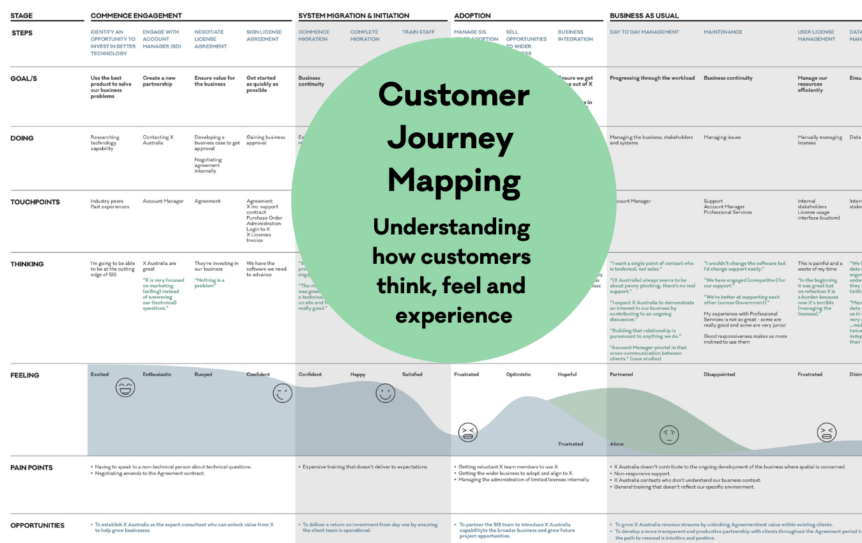The CX leader’s playbook is now brimful of methods, tech and tools to understand customers and their experiences. For many though, deep understanding; how customers think, feel and experience remains elusive. What’s changing this status quo is the rediscovery of customer journey mapping using qualitative research, analysis and visualisation to make sense of experiences that are becoming increasingly complex.
What to expect from a customer journey map
Firstly, for a little clarity. Customer journey mapping is the process of listening to understand the customer perspective, synthesising this data to understand its meaning, visualising what customers are thinking, feeling and doing, and using storytelling to communicate the customer’s experience.
The customer journey map represents the customer’s experience, clearly showing their physical, digital, human and non-human interactions. The journey can be as broad as all of the events in pre-purchase, usage and post-purchase stages or a deep-dive into a problematic stage of the customer’s experience.
Mapping the customer journey provides evidence of the experience; it’s the big picture. The map provides a visual of customers’ goals, unmet needs, painpoints and service gaps across each stage and step of their journey or relationship.
Journey maps also help everyone across the organisation understand what it is like to be a customer and importantly, what role they play in delivery; critical for aligning both customer-facing and non-customer facing employee teams. Additionally, a customer journey map is used as a framework for CX prioritisation of investment and resources and customer-centric decision making.
A customer journey map’s superpower
For executives and employees alike, visualising what customers are thinking, feeling and doing during their experience is the ‘aha moment’ in understanding customers. Emotions, how customers feel, have the power to connect — they enable us to feel what customers are feeling as if emotions were communicable.
Customer emotions on a journey map are expressed visually using an emotion graph. An emotion graph illustrates how customers feel at each interaction. Emotion icons or emoticons are a pictorial representation of facial expressions that indicate a particular emotion. They are used in conjunction with a graphic wave to represent the emotional highs and lows across the customer experience.
When CX leaders show and tell the customer story using the journey map, it has a profound effect — executives and employees lean in. They reach out and trace their fingers along the emotion graph, they read the customer verbatims to each other and they self-organise and huddle together in groups; sense-making, discussing the meaning and developing their understanding.
Customer journeys help us to perspective-take
Understanding the customer’s perspective, feeling what is like to be a customer can be thwarted by cognitive bias; mental shortcuts that speed up the ability to make judgments impacts our thinking, opinions and decisions.
Common prejudices such as conformation bias; the tendency to use information that confirms our existing beliefs, and the false consensus effect; the belief that others hold the same opinions that we do, influence our conclusions and can lead to bias in decision making.
When we look at something from a different perspective we can learn something new that we did not, or could not, otherwise have known. Perspective-taking enables leaders around the decision-making table to take into consideration customer goals, needs and perspectives; augmenting their assumptions and opinions with different ways to see the customer’s world.
However, customer perspective-taking requires more than assumptions about customers experiences. It requires deep discovery using qualitative research and analysis for insights that provide new points-of-view on the customer’s context, their attitudes and behaviours, and their experiences pre, during and post their relationship.
Using Voice of Customer surveys in the customer journeys
There are limitations in measuring CX with only Customer Satisfaction (CSAT) or Net Promotor Score (NPS) surveys. Typically, this data is captured at a customer touchpoint or transaction. There’s also growing customer fatigue with surveys and generally, lower response rates render this data statistically insignificant. As a metric, CSAT and scores also under-represent customers’ experiences. For example, a CX score doesn’t effectively measure customer emotion.
There are effective ways to use survey metrics that orientate the focus from a single touchpoint to the journey. The key is the deep discovery of the customers’ journey and then measuring the progress of customer goals such as paying an invoice or a stage of the journey such as onboarding. Another approach is using the metric pre and then post innovation to measure the level of success.
Discovering your customers’ world
Our customers’ world, how they live, work and socialise, is rapidly changing. Their journeys are more complex than can be measured using operational data, quantitative data and satisfaction scores alone. A deep discovery of how customers think, feel and experience, and mapping this complexity, enables new perspectives, new ways to see the customer’s experience and new ways to engage and connect the business through deeper understanding.


